Acer Aspire 5 A515-54-51DJ review: Slim and inexpensive, but middling quad-core performance – Chia Sẻ Kiến Thức Điện Máy Việt Nam
This slim $530 laptop packs in more than enough power for everyday computing tasks, and its quad-core performance is respectable, but you’ll have to settle for a dim display.
If you’re looking for an inexpensive quad-core laptop that’s less than three-quarters of an inch thick, the Acer Aspire 5 A515-54-51DJ might fit the bill. This slim laptop packs in more than enough power for everyday computing tasks, and its quad-core performance is respectable, if shy of awe-inspiring. A fingerprint reader and nearly all-day battery life will appeal to productivity-minded road warriors, although they’ll have to settle for a display that’s on the dim side.
This review is part of our ongoing roundup of the best laptops. Go there for information on competing products and how we tested.
Mục Lục
- Price and specifications
- Design
- Display
- Keyboard, trackpad, speakers, and extras
- Ports
- Performance
- PCMark 8 Work 2.0 Conventional
- HandBrake
- Cinebench
- 3DMark Sky Diver
- Battery life
- Bottom line
Price and specifications
Acer packs a bewildering number of configurations into its budget Aspire 5 line—at least 22 by my count, ranging from $350 (at presstime) for a dual-core AMD Ryzen 3 3200U-powered model with a bare-bones 4GB of RAM and a 128GB solid-state drive, all the way to a considerably beefier quad-core Core i7-8565 model with a hefty 12GB of RAM, a 512GB SSD, and dedicated Nvidia GeForce MX250 graphics that cost about $850 at the time of this writing. Most Aspire 5 versions boast a 15.6-inch display (although I spotted at least one 14-inch model), with a mix of 1080p and 720p resolutions.
The configuration we’re reviewing here is a middle-of-the-road model, complete with a quad-core Core i5-8265U CPU, a Whiskey Lake processor that debuted in late 2018 as a modest upgrade (mainly a slightly faster boost clock speed) to 2017’s Core i5-8250U Kaby Lake Refresh chip. Comparable to a Core i7 processor from a couple of generations prior, the i5-8265U is a solid workhorse that can hold its own when it comes to CPU-intensive tasks like video editing.
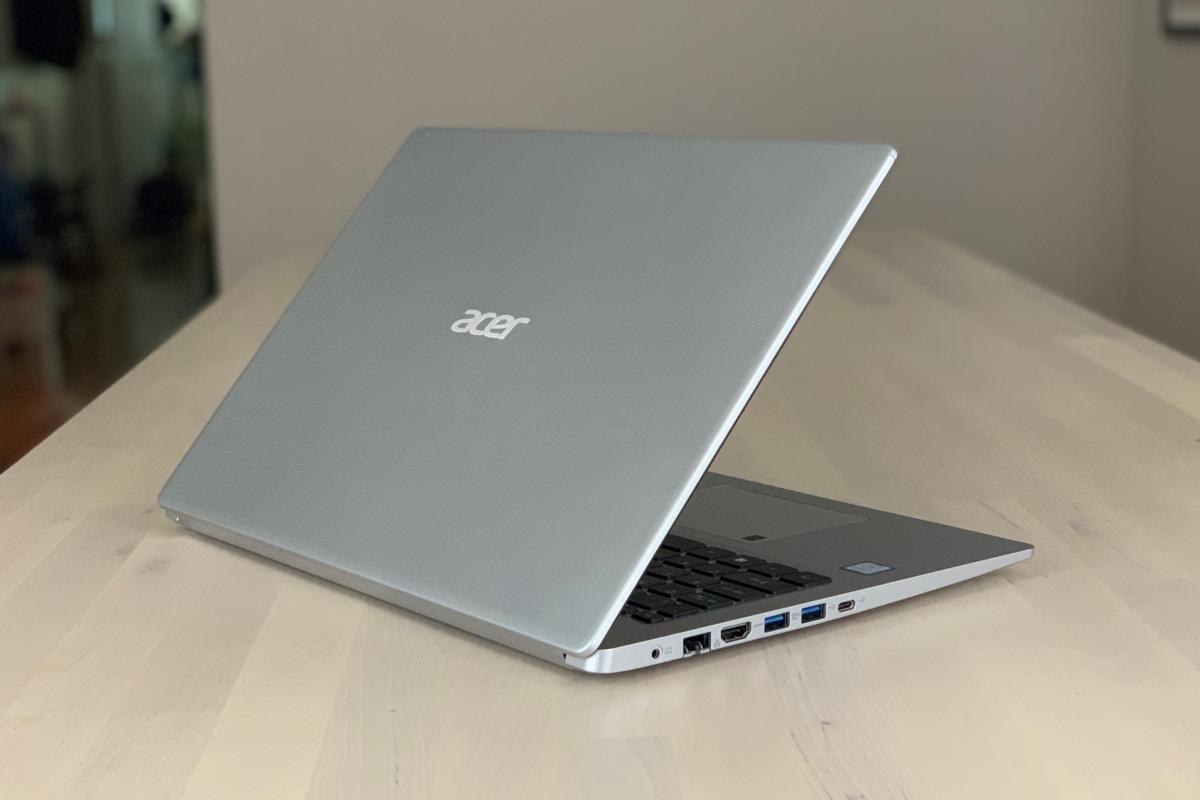 Ben Patterson/IDG
Ben Patterson/IDG
The Core i5-powered version of the Acer Aspire 5 comes with an impressively slim and trim shell.
Also on board: a reasonable 8GB of RAM, which helps to smooth out performance when running multiple programs at once; a 256GB SSD, a decent amount of storage for a speedy solid-state drive; an integrated Intel UHD Graphics 620 chip, and a full-HD (1920×1080) 15.6-inch display.
On paper, that all adds up to a relatively sturdy workhorse for everyday computing chores like web browsing and composing Office documents, Intel’s integrated UHD 620 will let you do a little light gaming, but think Minesweeper more than Fortnite.
If you’d prefer to spend a little less money, check out our review of this $399 Aspire 5 with a dual-core Core i3 processor, which lacks the Core i5’s quad-core power but still packs a punch when it comes to day-to-day desktop tasks.
Design
The laptops in Acer’s Aspire 5 line do a nice job of feeling thinner and lighter than they really are. This particular model of the Aspire 5 is no different: Yes, it tips the scales at nearly 4.25 pounds, but at just 0.7 inches thin the Aspire 5 manages to feel reasonably light, particularly given its sizable 14.3-by-9.9-inch footprint.
The laptop’s slim aluminum lid and tapered shell make it look fairly stylish for a budget laptop. Opening the lid reveals the 15.6-inch display with svelte left and right bezels, a dapper “Aspire” logo along the laptop hinge, and a silver-colored chassis offset by the black keyboard. Incidentally, the lid bends way back slightly beyond 180 degrees, which means you can lay the Aspire completely flat with the lid open.
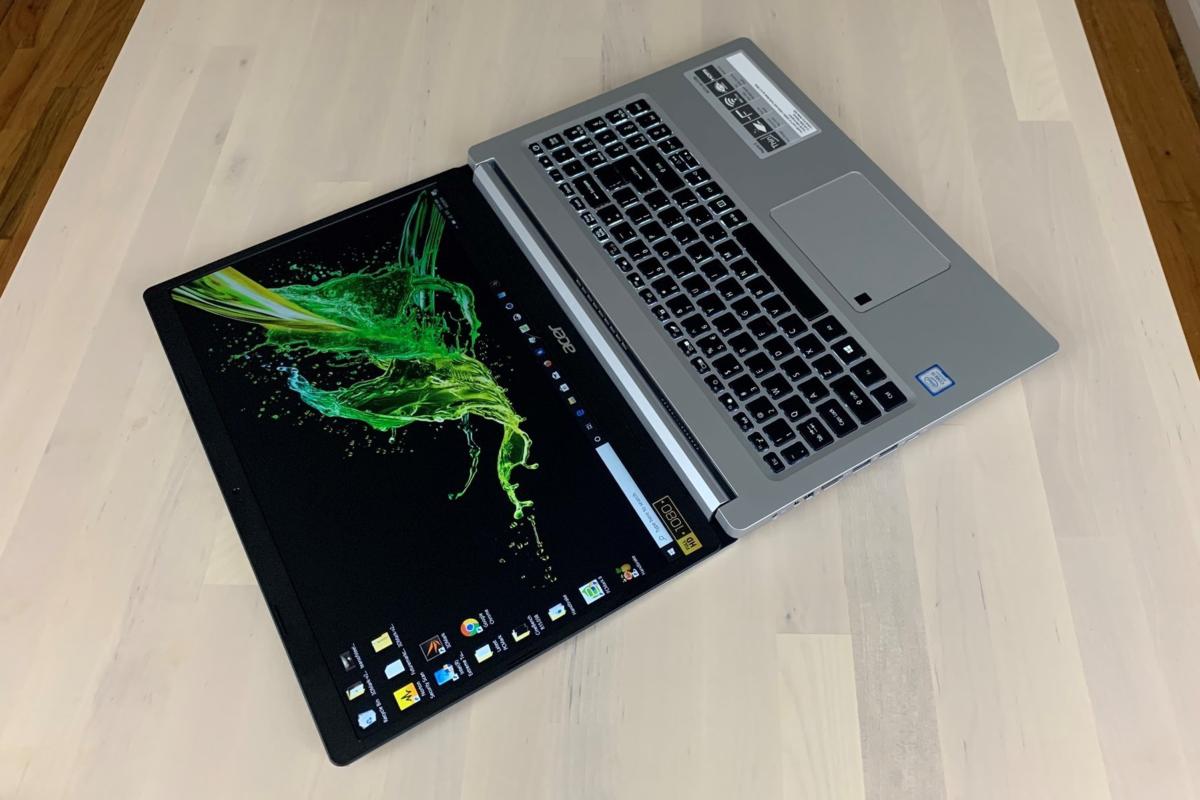
Ben Patterson/IDG
Ben Patterson/IDG
You can lay the Aspire 5 flat on a table with its lid open, if the mood strikes you.
Turning the Aspire 5 upside-down, we find a pair of small speaker grilles near the front and a large cooling vent near the back. There are also 11 Phillips-head screws that look as though they’re inviting you to remove the bottom panel, and what’s this: an extra hard drive bracket? Alas, while you probably could go ahead and pop off the bottom panel, a note in the box warns that cracking open the chassis yourself could void the warranty, so you might want to leave the upgrades to an authorized service dealer.
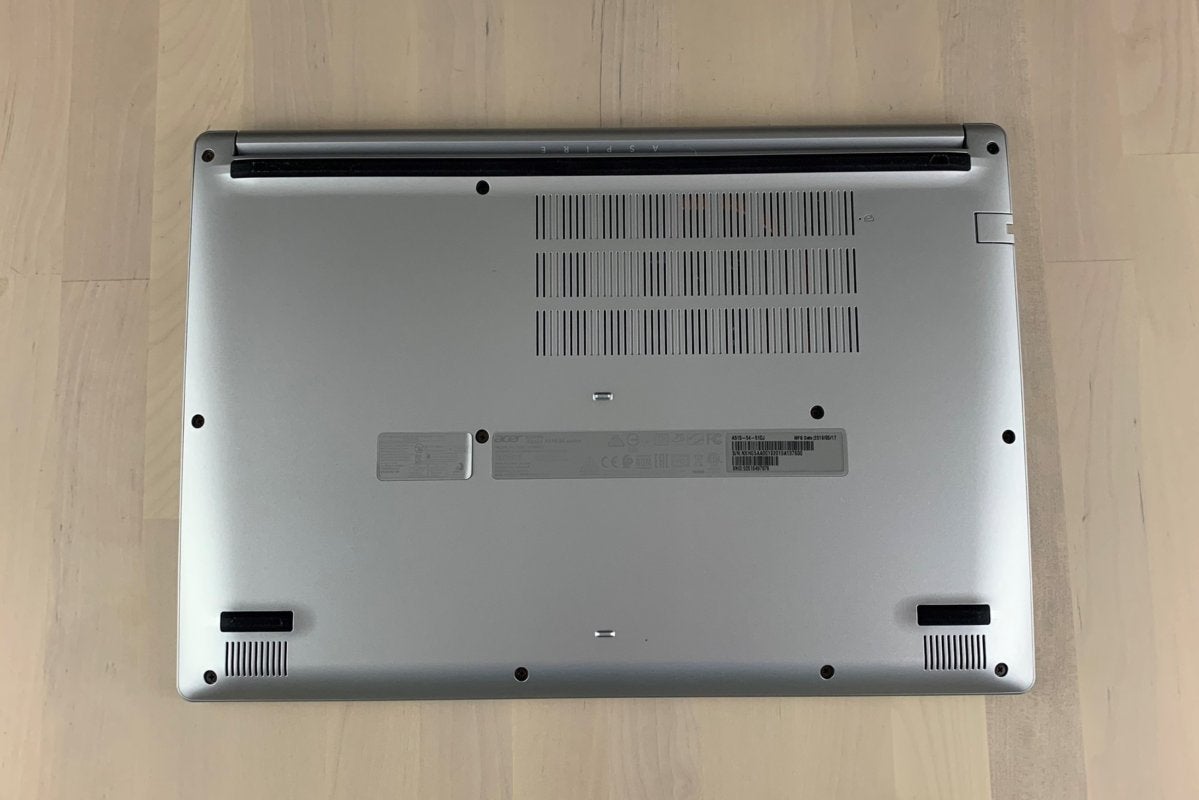 Ben Patterson/IDG
Ben Patterson/IDG
You could remove the Aspire 5’s bottom panel with a screwdriver, but doing so might void the laptop’s warranty.
Display
When it comes to the Aspire’s display, let’s start with the positives. Its 1920×1080 resolution is the minimum we like to see when dealing with a 15.6-inch screen. The Aspire’s IPS (in-plane switching) panel makes for solid viewing angles, with the display looking relatively bright and readable even when looking from the side, above, or below. The display’s matted “ComfyView” design minimizes glare, though direct outdoor sunlight will fight back hard.
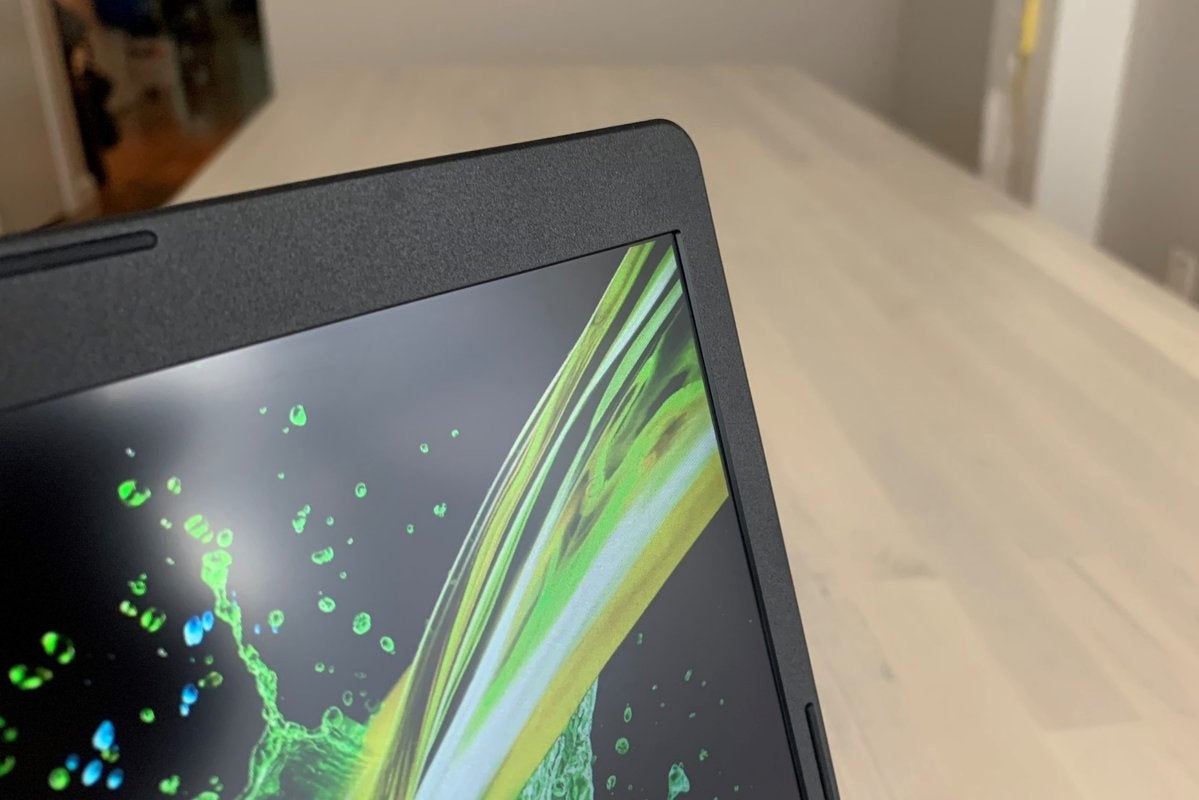 Ben Patterson/IDG
Ben Patterson/IDG
Ben Patterson/IDG
We like the slim bezel on the left and right side of the Aspire 5’s display, but screen brightness leaves something to be desired.
Unfortunately, the display on this particular model of the Aspire 5 is disappointingly dim—just 201 nits (or candelas) according to our measurements, which is well below the 250 nits we generally prefer. While the Aspire 5’s screen looked bright enough indoors, it began to fade noticeably when I was using it outside in the shade, and it looked even worse in direct sunlight.
Keyboard, trackpad, speakers, and extras
The Aspire 5 offers a roomy backlit keyboard complete with a 10-key numeric keypad. The latter is a tad too squished for our liking, but it’s there. The keys themselves felt good to type on, delivering a satisfying bump and springy rebound on each keystroke. That said, travel (basically a measure of how far the key travels on each stroke) felt a bit skimpy compared to other productivity-minded laptops I’ve tested.
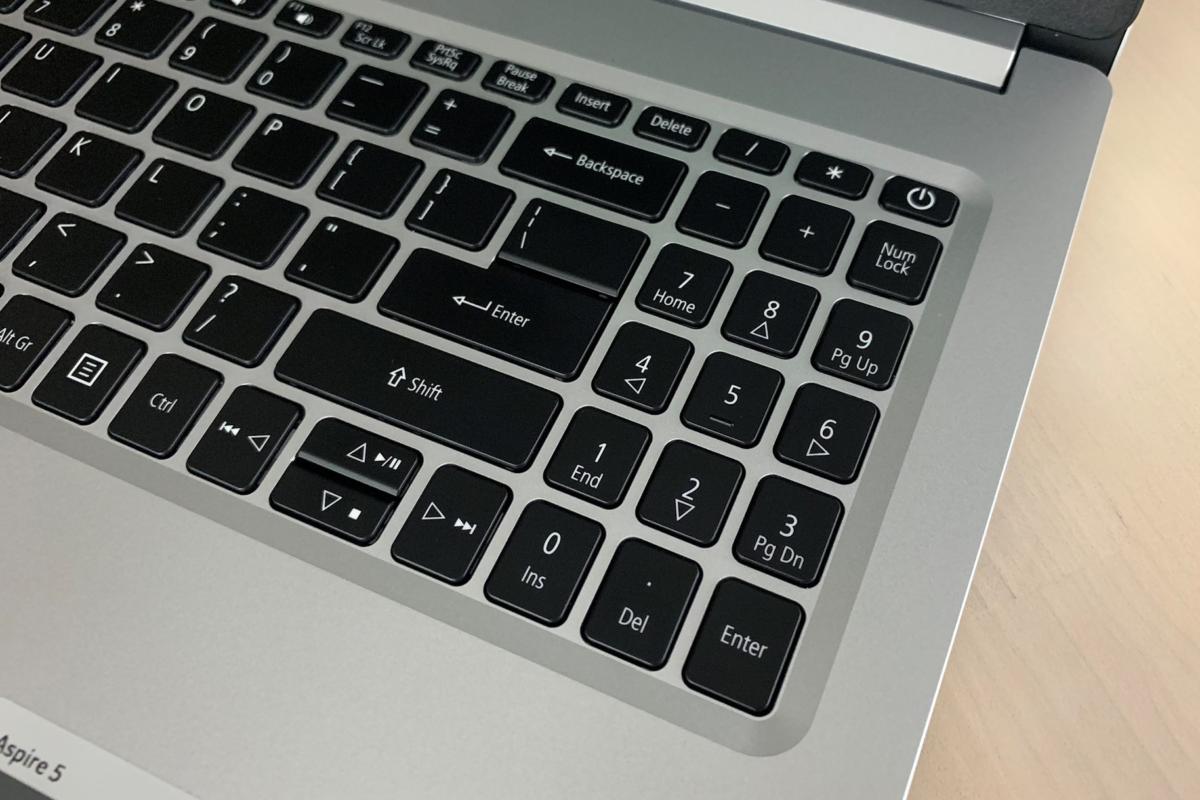 Ben Patterson/IDG
Ben Patterson/IDG
The backlit keyboard on the Aspire 5 comes with a dedicated (but narrow) numeric keypad.
The Acer Aspire 5’s roomy trackpad felt smooth and responsive during my testing. I did occasionally notice the cursor jittering across the screen as my palms dragged over the trackpad surface while typing. It was only slightly annoying, but trackpads on other laptops I’ve tested have done a better job at rejecting such false inputs.
Back on the plus side, the trackpad comes with a fingerprint reader, handy for signing into your Windows profile or any Windows Hello-compatible apps by pressing your fingertip on the sensor. I used the fingerprint reader, which sits in the top-left corner of the trackpad, repeatedly throughout my testing and didn’t have any problems.
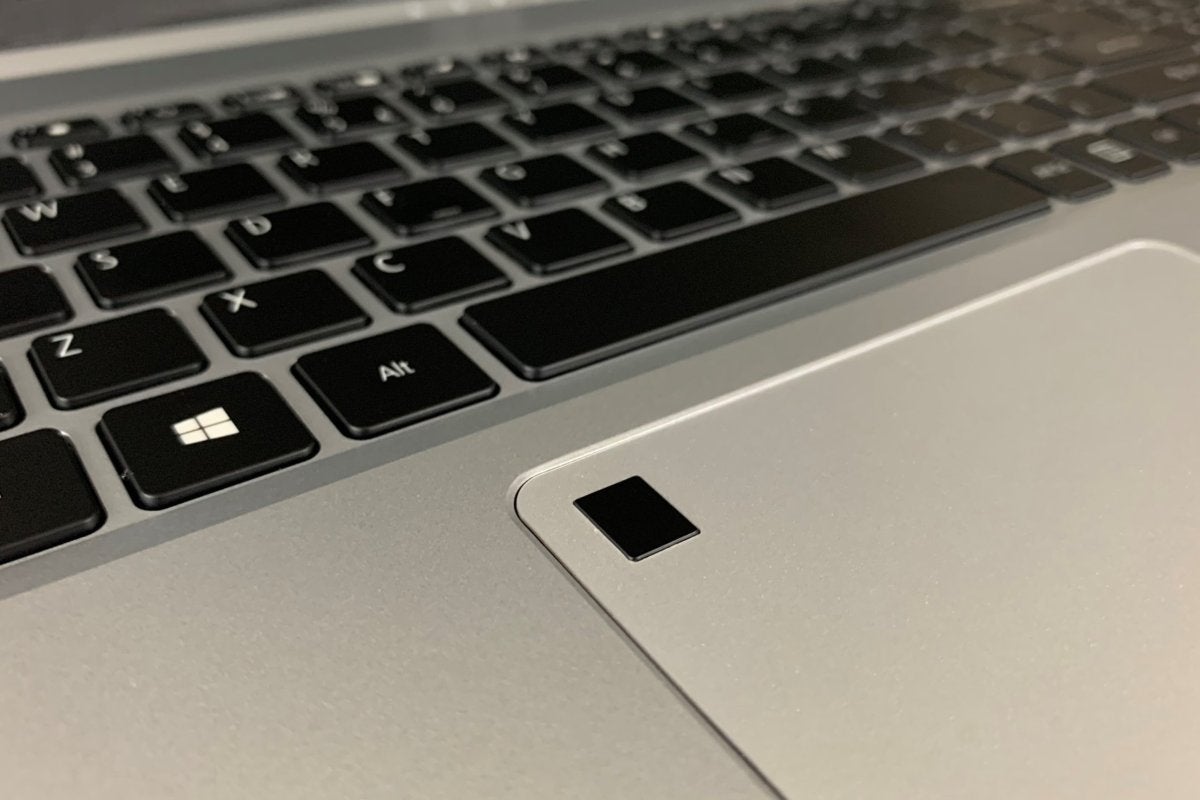 Ben Patterson/IDG
Ben Patterson/IDG
A fingerprint reader is always a nice touch, and the one on the Aspire 5 was fairly reliable during my testing.
The stereo speakers on the Aspire 5 are about as mediocre as those on most other laptops we’ve tested. You can crank them nice and loud, which is a plus, and they even deliver a hint of bass, although the sounds gets muddy at higher volumes. We’ve definitely heard worse.
Ports
The Aspire 5’s collection of ports offers a decent selection of new and legacy options. On the left side, you’ve got a full-on Gigabit ethernet port for an old-school wired connection to your router. You don’t often see ethernet ports in laptops this thin, but this one has a “dropjaw” spring mechanism so the port can expand to accommodate a cable connector. You also get a couple of speedy USB 3.0 Type-A ports, HDMI, and a USB 3.1 Gen 1 Type-C port for connecting newer USB-C-equipped storage devices and peripherals.
 Ben Patterson/IDG
Ben Patterson/IDG
On the left side of the Aspire 5, you’ll find a pair of USB 3.0 Type-A ports, along with Gigabit ethernet, HDMI, and a USB 3.1 Gen 1 Type-C port.
On the right, you get a USB 2.0 Type-A port, plus a combo audio jack.
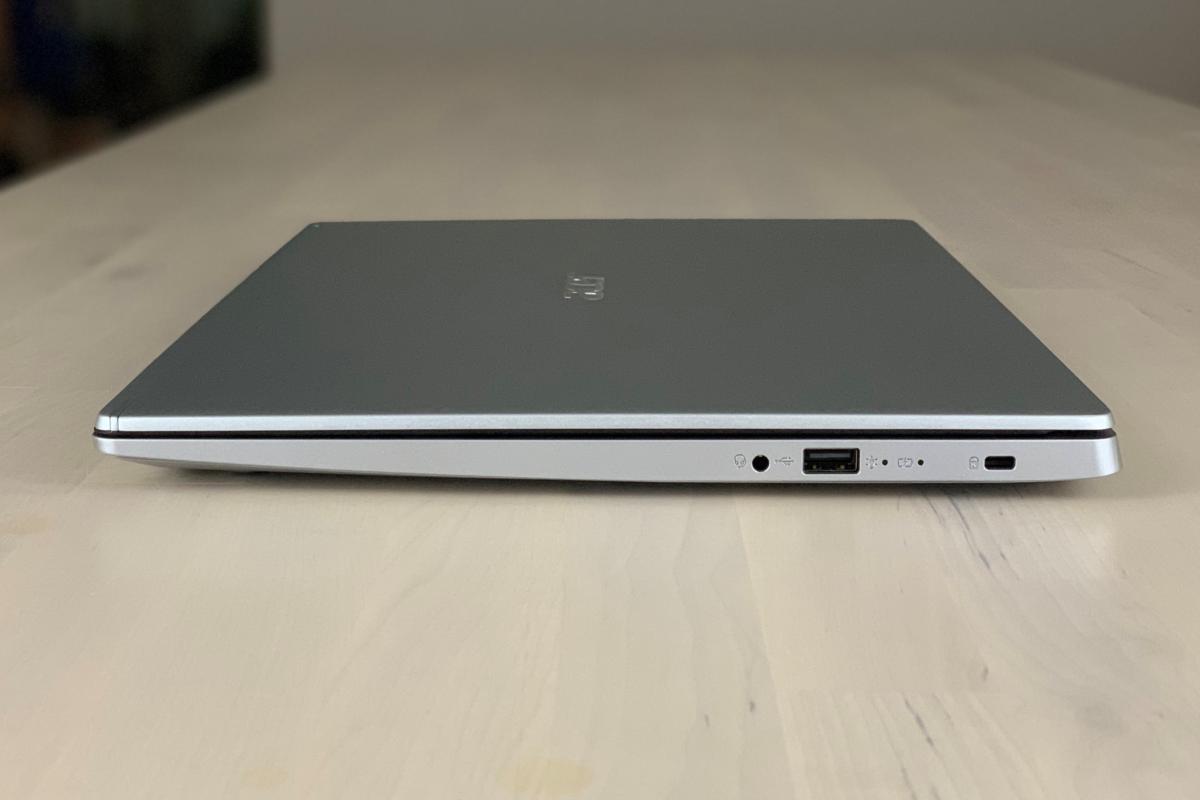 Ben Patterson/IDG
Ben Patterson/IDG
There’s a USB 2.0 Type-A port and a combo audio jack on the right side of the Aspire 5, but no memory card reader.
Disappointingly, there’s no memory card reader, which means you won’t be able to pop in memory cards from your Android phone or your digital camera.
Performance
With its middle-of-the-road specs, we were expecting middle-of-the-road performance from this Core i5-equipped version of the Acer Aspire 5, and that’s pretty much what we experienced.
The good news is that the Aspire’s got it where it counts, putting up excellent scores when it comes to everyday productivity—think web browsing, Office productivity, playing tunes, and even some light photo editing. That said, the Aspire’s quad-core processor chugs a bit when it comes to CPU-intensive activities, particularly video encoding.
PCMark 8 Work 2.0 Conventional
The PCMark 8 Work 2.0 benchmark simulates such routine desktop activities as composing text documents, fiddling with spreadsheets, shopping on the web, video conferencing, and other day-to-day activities—in other words, the routine desktop chores that are squarely in the Aspire 5’s wheelhouse. Generally speaking, a score of 2,000 or better on the PCMark 8 benchmark means you can expect smooth Office performance.
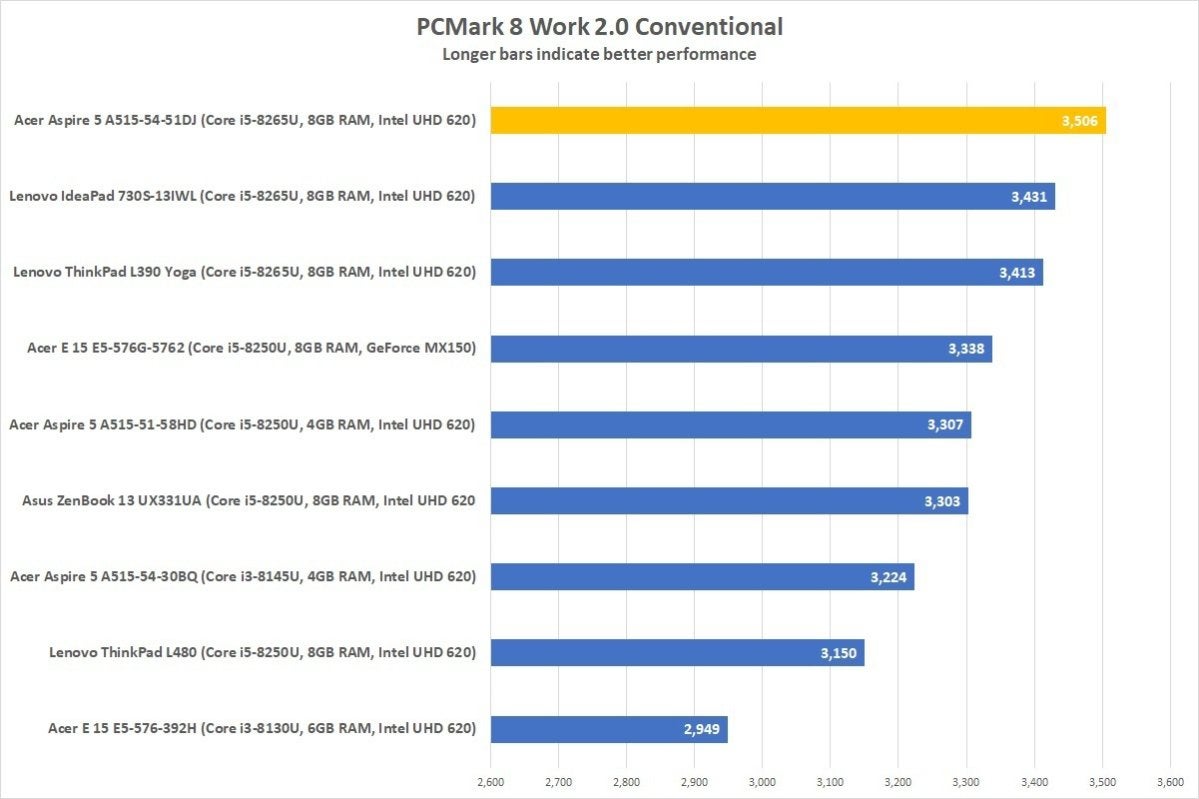 Ben Patterson/IDG
Ben Patterson/IDG
The Core i5-based Acer Aspire 5 gets high marks for its PCMark 8 performance.
The results were impressive, with this particular configuration of the Aspire 5 topping our chart of similar Core i5-powered laptops in roughly the same price range. The Aspire’s PCMark 8 score of a little over 3,500 easily cleared our low-water mark of 2,000 for this benchmark, and it even bests the numbers of competing laptops that cost hundreds of dollars more, although some of those pricier laptops are also much smaller and lighter (and thus tougher to keep cool) than the Aspire.
HandBrake
A considerably tougher test than PCMark 8, our HandBrake benchmark measures how long it takes for a given laptop to convert a 40GB video file into an Android tablet-compatible format. Whereas PCMark 8 is a single-core workout for a CPU, Handbrake demands peak performance from all of a processor’s cores, meaning that the chip with the most cores will generally win out.
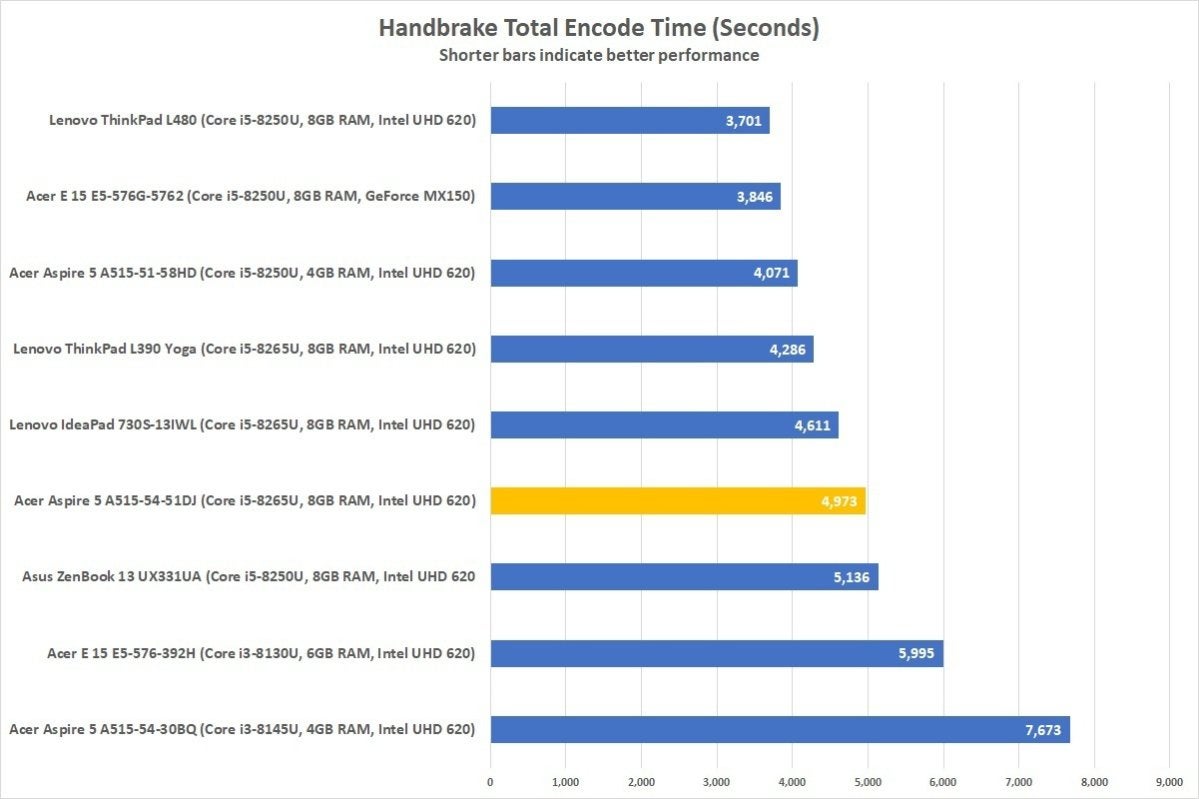 Ben Patterson/IDG
Ben Patterson/IDG
One reason for the Aspire 5’s middling Handbrake score is that its quad-core CPU frequently throttles itself to keep things cool.
Like most of the laptops in our comparison chart, the Core i5-powered Aspire 5 has a quad-core processor, and indeed, the Aspire’s 4,973-minute score lands in the ballpark, albeit near the rear of the pack. Ahead of the Aspire are laptops that are either much pricier (like the Lenovo ThinkPad L480) or bigger and therefore easier to cool (like the hefty Acer E 15). Lagging behind the Aspire is the 2.7-pound Asus ZenBook 13. As expected, a couple of dual-core Acer laptops, including a Core- i3-packing version of the Aspire 5 line (full review coming soon), bring up the rear.
Looking under the hood using Intel’s Extreme Tuning Utility, we can see that the Aspire is frequently engaging thermal throttling during the HandBrake test. In other words, it’s repeatedly pumping the brakes on the CPU’s performance to keep it from overheating, most likely a concession to the Aspire’s slim chassis.
The Aspire’s so-so HandBrake score matters only if you have ambitious plans for this laptop. Activities like web browsing and editing Office documents don’t demand multi-core performance; generally speaking, the CPU only needs a single core to handle most mainstream desktop chore. The PCMark 8 benchmark already told us that the Aspire sails right through those types of tasks.
If you’re planning on editing 4K videos, however, then yes, the Aspire 5 may get sluggish as it tries to cool itself off. It’ll still get the job done much faster than a dual-core laptop could.
Cinebench
Another benchmark that pushes a CPU to its limits, Cinebench measures how long it takes for a given system to render a 3D image in real time. It’s another multi-core torture test, and again, we should look for laptops with the most processor cores to be topping the chart.
 Ben Patterson/IDG
Ben Patterson/IDG
As with Handbrake, the Aspire 5’s all-threads Cinebench score is lower than we’d like, although its single-thread score is right where it should be.
Reflecting the results of the HandBrake test, the Core i5-powered Acer Aspire 5 again brings up the rear of the Core i5 pack in the multithread Cinebench test, although it’s by no means a blowout. Indeed, while we (again) saw the Aspire 5 dialing down its CPU via thermal throttling during the test, its 493 all-threads Cinebench score is still relatively respectable.
Also interesting are the single-thread Cinebench test results, which shows the Core i5-powered Aspire 5 basically even with its competition, save for the much heavier Aspire E15 and expensive Lenovo IdeaPad. The Aspire 5’s relatively strong single-threaded performance bodes well when it comes to everyday computing duties.
3DMark Sky Diver
With its integrated Intel UHD Graphics 620 core, it’s unfair to expect much from the Aspire 5 in terms of gaming, but we put it through its paces anyway with the 3DMark Sky Diver graphics benchmark.
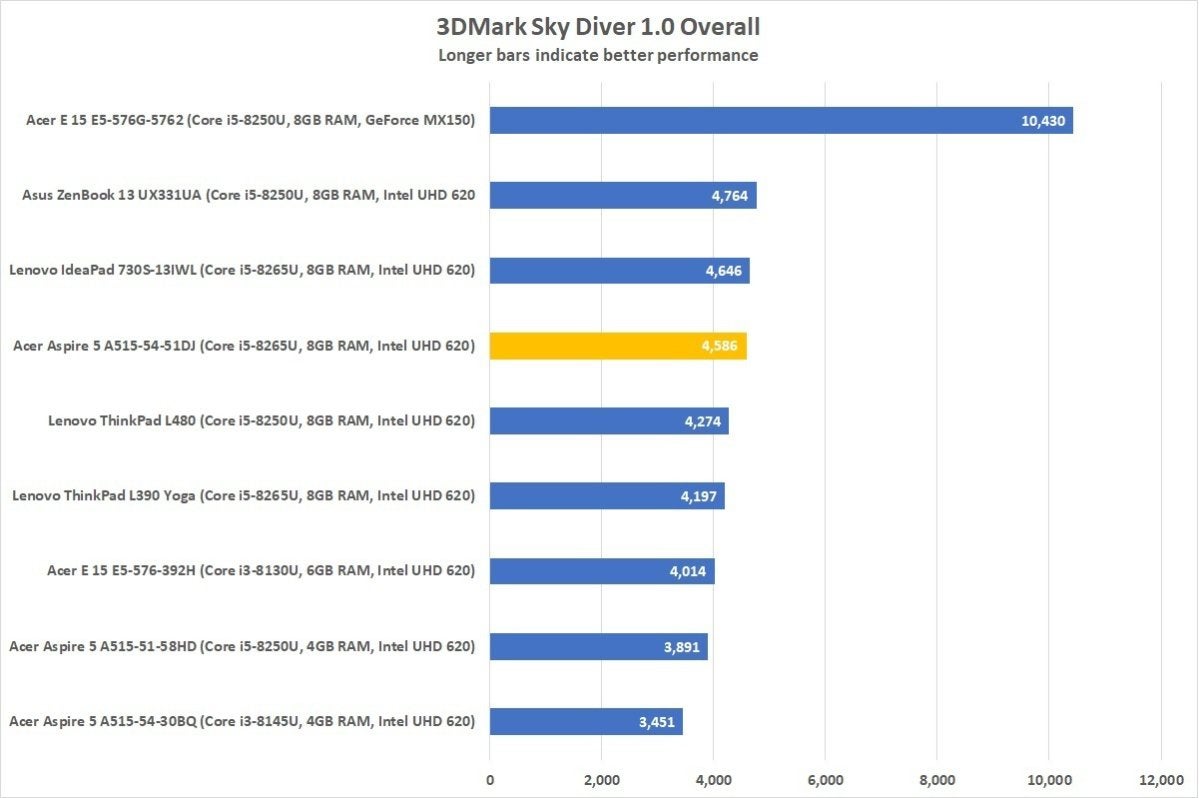 Ben Patterson/IDG
Ben Patterson/IDG
The Aspire 5 and its integrated graphics core sits bunched up with similarly configured laptops, while the Acer E 15 tops the chart thanks to its discrete graphics card.
No surprises here, with the i5-packing Aspire 5 in the top third of its class in our chart. What’s that one laptop at the top that’s blowing all the others away? It’s the Core i5-enabled Acer E 15, a bargain-priced laptop with an ace up its sleeve: a discrete GeForce MX150 graphics card. The MX150 is no powerhouse, mind you, but it illustrates the difference that even an entry-level discrete graphics card can make.
Battery life
We test battery life on laptops by looping a 4K video over and over using the stock Movies & TV playback app for Windows, with the screen brightness tuned as closely as possible to 250 nits (which meant cranking the Aspire’s brightness all the way up) and with the volume set to 50 percent, with headphones plugged in.
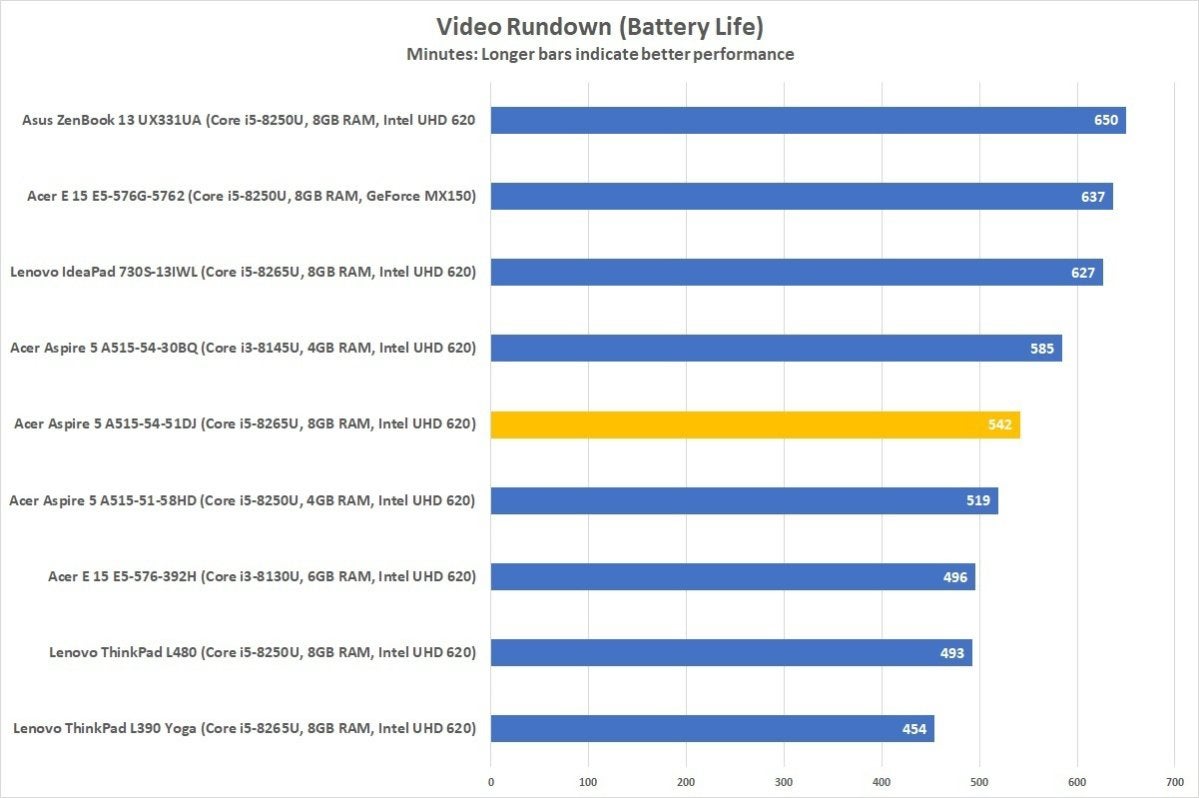 Ben Patterson/IDG
Ben Patterson/IDG
With a little more than nine hours of battery life in our testing, the Aspire 5 is perfect for day-tripped without a power adapter.
On average, it took a little over 9 hours for the 49 watt-hour battery in the Core i5-equipped Aspire 5 to die, which is right in line with our expectations. Topping the list is the Asus ZenBook 13, which wrings an exceptional amount of juice out of its similar-sized battery. The Acer E 15 benefits from a larger 62 watt-hour battery. In any event, the Aspire 5’s nine-hour result in our battery rundown trial means close to all-day battery life.
Bottom line
Capable of smooth-as-butter performance for mainstream computing activities, this Core i5-powered version of the Acer Aspire 5 manages to pack quad-core power into a thin, budget-priced chassis. But while it can run Office like a charm, the Aspire’s quad-core performance isn’t quite as impressive, and we’re also disappointed by its dim display.






